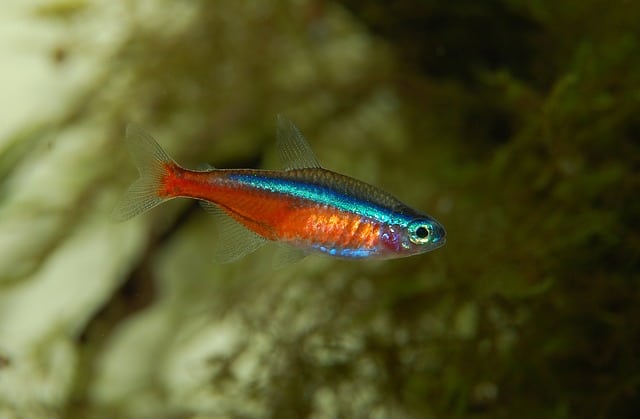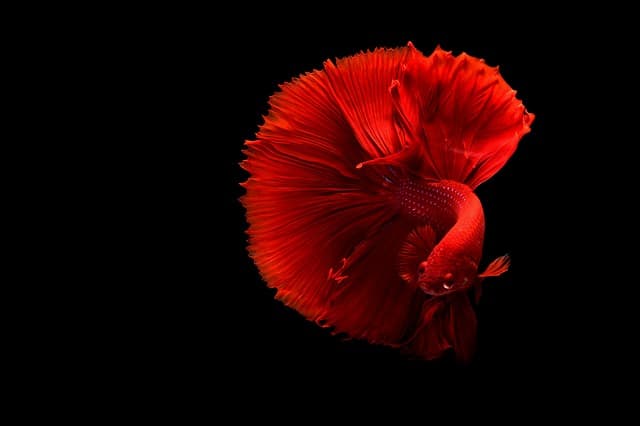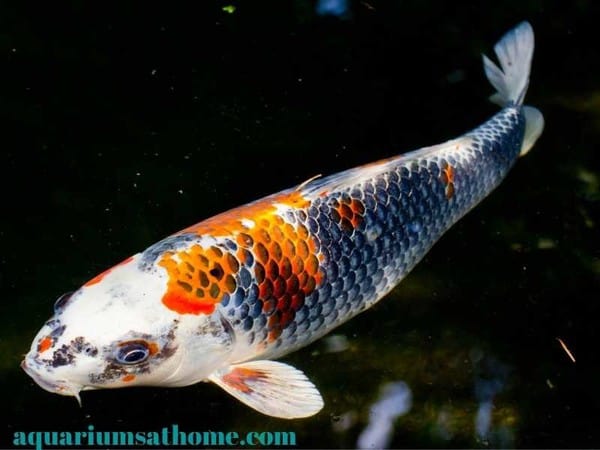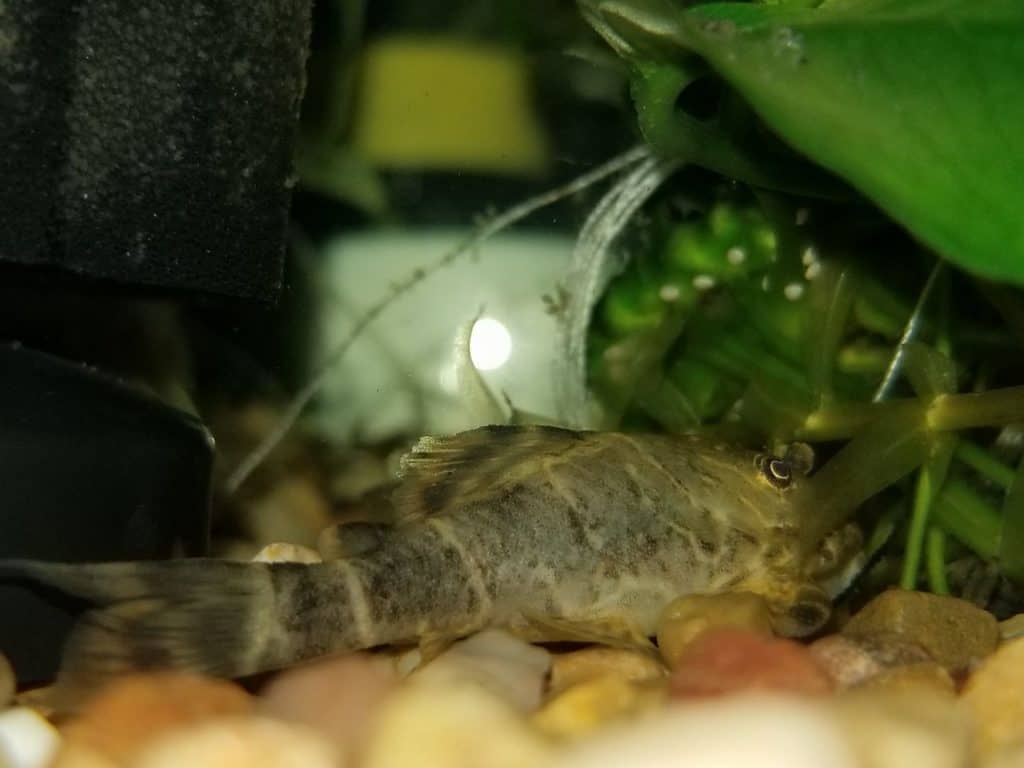Welcome fellow aquarium enthusiasts! For over three decades, I’ve been fascinated by the colorful, energetic Danio fish and I can’t wait to share my knowledge and experiences with you.
In this article, we’ll explore the captivating world of Danio fish tank mates and the art of creating a harmonious underwater community.
Choosing suitable companions for your Danios is essential for maintaining a thriving and peaceful aquarium and I’ll guide you through the process with excitement and passion.
Characteristics of Danio Fish
Let’s start by getting to know our star players, the Danio fish. These vibrant, active creatures are native to Southeast Asia and belong to the Cyprinidae family. Commonly kept species include the Zebra Danio (Danio rerio), the Pearl Danio (Danio albolineatus), and the Giant Danio (Devario aequipinnatus).
Danios are known for their striking colors, playful behavior, and social nature, making them a popular choice for community tanks.
Tank Size and Water Parameters
Before diving into tank mates, it’s crucial to provide Danio fish with a comfortable and spacious environment. A well-maintained aquarium of at least 20 gallons is recommended for a small group of Danios.
These fish thrive in water with a pH range of 6.5 to 7.5, a temperature between 72°F to 78°F (22°C to 26°C), and moderately hard water.
Factors to Consider When Choosing Tank Mates
Peaceful and Compatible Species
As experienced hobbyists know, harmony is key in a community tank. To complement our energetic Danios, we should select peaceful fish that won’t intimidate or harm them. Peaceful tetras such as Neon Tetras (Paracheirodon innesi) and Harlequin Rasboras (Trigonostigma heteromorpha) make excellent companions for Danios, promoting a sense of camaraderie and reducing stress among tank inhabitants.
Water Parameters Compatibility
Maintaining a balanced ecosystem relies on ensuring that all tank mates share similar water parameter requirements. Avoid mixing species with drastically different pH, temperature, or hardness preferences. Incompatible water conditions could lead to stress, sickness, and potentially fatal consequences for our beloved Danios.
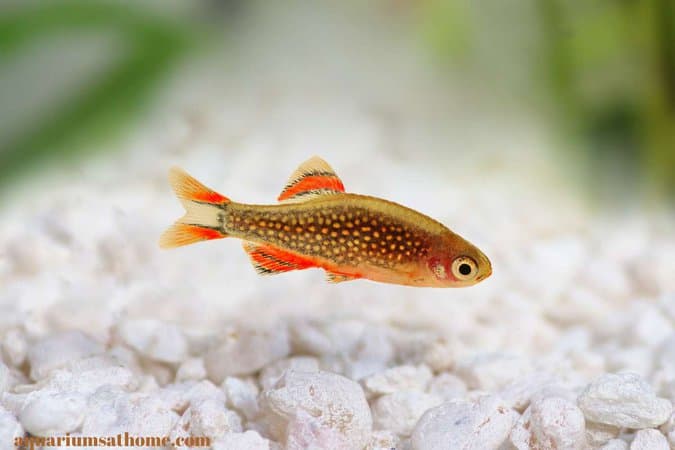
Feeding Habits and Diet
In the underwater world, sharing is caring. When choosing tank mates, consider their dietary preferences and ensure that all fish receive proper nutrition. Danios are omnivorous and eagerly consume flake, pellet, and live foods. Suitable companions should have compatible feeding habits, allowing everyone to enjoy mealtime without competition.
Recommended Tank Mates for Danio Fish
Now that we understand the factors to consider, let’s explore some fantastic tank mates that can form a cohesive community with Danios:
Suitable Community Fish
A diverse community is a harmonious one! Peaceful community fish like the Cherry Barb (Puntius titteya) and the Celestial Pearl Danio (Danio margaritatus) can coexist happily with Danios. The playful interactions between these species will undoubtedly captivate any observer.
Bottom-dwelling Species
Completing the aquarium’s ecosystem, bottom-dwelling fish play a vital role in maintaining cleanliness and balance. Consider adding friendly bottom-feeders like Corydoras catfish, who will happily sift through the substrate while Danios frolic in the mid-water column.
Middle and Top-dwelling Fish
To utilize the entire aquarium space effectively, consider middle and top-dwelling species that occupy different zones. The Endler’s Livebearer (Poecilia wingei) and the peaceful Guppies (Poecilia reticulata) are great choices for the upper levels, adding a splash of color and liveliness to the tank.
Below you can find a list of my top 10 tank mates for Danio’s. Make sure to check it out.
Incompatible Tank Mates to Avoid
In the pursuit of creating an ideal community, it’s equally essential to identify and avoid problematic tank mates. Let’s take a closer look at those who might not play well with Danios:
Aggressive Fish Species
Aggressive fish such as Cichlids and Barbs should be kept far away from your peaceful Danios. Aggression can lead to constant stress for Danios, resulting in a negative impact on their health and behavior.
Fin-nippers and Harassers
Fin-nipping is not only harmful to the victim but also disrupts the overall harmony of the tank. Species like Tiger Barbs (Puntigrus tetrazona) and some Betta splendens variants are notorious fin-nippers and should never be housed with Danios.
The Quarantine Process
Introducing new tank mates into your aquarium should be a thoughtful and cautious process. Quarantine newly acquired fish in a separate tank to ensure they are free from diseases and parasites. This prevents potential health issues from spreading to your existing community.
Monitoring and Observation
As an experienced hobbyist, I can’t emphasize enough the significance of regular observation. Monitor the behavior and health of all tank mates to detect any signs of stress, aggression, or illness. Early intervention can prevent potential conflicts and maintain a happy community.
The Importance of Acclimation
Acclimation, the Key to Success
Acclimating new tank mates to your existing community is a critical step in ensuring their well-being and overall harmony in the aquarium. Abrupt changes in water parameters and social dynamics can cause stress and even lead to territorial disputes among fish.
By adopting a gradual acclimation process, you allow the newcomers to adjust to their new environment at a comfortable pace.
Techniques for Acclimation
There are several methods to acclimate fish to your aquarium, but the drip acclimation technique is often the most effective and gentle approach. To implement this method, float the bag containing the new fish in the aquarium for about 15-20 minutes to equalize the temperature.
Afterward, open the bag and use a siphon or airline tubing to slowly drip water from the tank into the bag over the course of 1-2 hours. This slow process helps the fish acclimate to both temperature and water parameters gradually.
Exploring Danio Fish Behavior in Community Tanks
Shoaling Behavior and Social Dynamics
The Importance of Shoaling
Danios are naturally shoaling fish, meaning they have a strong inclination to swim and socialize in groups. In the wild, Danios form large schools which serve various purposes including protection from predators, increased foraging efficiency, and fostering a sense of security among individuals.
In a community tank, replicating this natural behavior is crucial to keeping your Danios happy and stress-free.
Interactions Within the Community
Observing the interactions between your Danio fish and other tank mates can be a rewarding experience. Danios, with their playful nature, often engage in chasing games and quick displays of energy. You may notice them forming mini schools within the larger community, creating an eye-catching display of color and motion.
Understanding these social dynamics helps ensure that their tank mates don’t inadvertently disrupt their shoaling behavior.
Zoning and Space Utilization
Utilizing Different Zones in the Aquarium
In a well-designed community tank, fish will naturally utilize different zones based on their preferences and habits. Danios, being primarily mid-water dwellers, enjoy plenty of horizontal swimming space. On the other hand, bottom-dwelling species such as Corydoras catfish thrive in areas with soft substrates where they can sift through the sand in search of food.
By providing a variety of spaces that cater to different species’ needs, you create a balanced and engaging environment.
Creating a Multi-Level Aquascape
Achieving an aesthetically pleasing and functional aquascape involves incorporating elements that cater to all zones of the aquarium. Use tall plants, driftwood, and floating vegetation to create areas for top-dwelling species since mid-level swimmers like Danios appreciate open areas with minimal obstacles.
The substrate should be carefully chosen to suit the needs of bottom-dwelling species with rounded gravel or sand being an excellent option.
The Magic of Schooling Fish
Rasboras and Danios: Schooling Companions
Mixed Schools in the Aquarium: One of the most visually stunning sights in a community tank is the blending of different species into a harmonious mixed school. Combining the shoaling behaviors of Danios with other peaceful schooling fish such as Harlequin Rasboras creates a mesmerizing dance of colors and patterns.
The fluidity of the mixed school captivates both seasoned hobbyists and newcomers to the aquarium world alike.
Ideal Rasbora Species for Schooling: When considering Rasboras as tank mates for Danios, certain species are better suited for schooling due to their temperament and activity level. Harlequin Rasboras (Trigonostigma heteromorpha) and Lambchop Rasboras (Trigonostigma espei) are excellent candidates as they are peaceful, hardy, and share a similar preference for mid-level swimming.
Loaches and Danios: A Dynamic Duo
Loaches as Bottom-dwelling Companions: Loaches, with their entertaining antics and effective algae-eating abilities, make fantastic additions to the bottom-dwelling region of your aquarium. Some popular loach species, like the Dwarf Chain Loach (Ambastaia sidthimunki) and the Yo-Yo Loach (Botia almorhae), are well-known for their peaceful temperament and ability to coexist with Danios.
Identifying Suitable Loach Species: When choosing loaches as tank mates, it’s essential to select those that share similar water parameters and dietary requirements with your Danios. Additionally, some larger loach species like the Clown Loach (Chromobotia macracanthus) can grow quite large and may not be suitable for smaller community tanks.
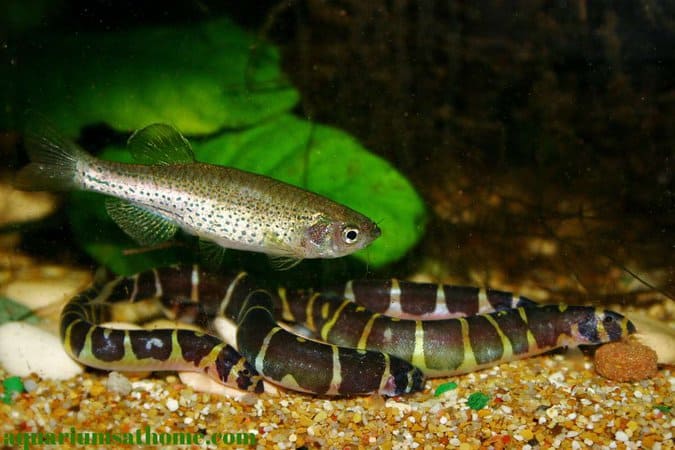
Top 10 Best Suitable Tankmates for Danios
Harlequin Rasbora (Trigonostigma heteromorpha): The Harlequin Rasbora is an ideal companion for Danios due to its peaceful nature and similar mid-water swimming habits. Both species create a mesmerizing mixed school, enhancing the visual appeal of the aquarium.
Corydoras Catfish (Corydoras sp.): Corydoras Catfish are gentle bottom-dwellers that complement Danios perfectly. They help keep the substrate clean by scavenging for leftover food and their playful antics add charm to the aquarium.
Neon Tetra (Paracheirodon innesi): Known for their stunning iridescent blue and red coloration, Neon Tetras coexist peacefully with Danios. Their small size and non-aggressive behavior make them a top choice for community tanks.
Celestial Pearl Danio (Danio margaritatus): These tiny and colorful fish are a natural fit for Danio communities. Their active nature matches that of Danios and their striking appearance creates an eye-catching display in the mid-water level.
Ember Tetra (Hyphessobrycon amandae): Ember Tetras are small, peaceful fish that prefer schooling, making them excellent companions for Danios. Their warm reddish-orange coloration adds a vibrant touch to any aquarium.
Guppies (Poecilia reticulata): Guppies are another popular choice for community tanks and they get along well with Danios. Their diverse colors and patterns add a lively and dynamic element to the aquarium.
Kuhli Loach (Pangio kuhlii): These slender, eel-like loaches are intriguing to observe as they weave through the aquarium’s bottom. Their peaceful nature and compatibility with Danios make them a valuable addition to the community.
Endler’s Livebearer (Poecilia wingei): Endler’s Livebearers share many similarities with guppies, but they have their unique charm. They are easy to care for and add a delightful assortment of colors to the tank.
Cherry Barb (Puntius titteya): Cherry Barbs are peaceful and colorful fish that blend well with Danios. They prefer swimming in the middle to upper water levels, creating a harmonious coexistence in the aquarium.
Zebra Loach (Botia striata): Zebra Loaches are active bottom-dwellers that enjoy burrowing in soft substrates. Their calm demeanor and scavenging behavior complement Danios, fostering a balanced ecosystem.
These top 10 suitable tank mates for Danios have been chosen based on their peaceful temperament, compatible swimming habits, and ability to coexist harmoniously in a community setting. With any combination from this list, you can create a captivating and vibrant aquarium full of life and energy.
Enhancing the Aquatic Environment
Plants and Decorations for Community Tanks
The Benefits of Live Plants: Live plants provide a myriad of benefits to your aquarium and its inhabitants. Besides enhancing the aesthetics, they play a crucial role in maintaining water quality by absorbing excess nutrients and providing hiding spots for shy or small fish. For Danios, who enjoy darting through foliage, live plants offer an enriching and stimulating environment.
Choosing Suitable Decorations: When selecting decorations for your community tank, opt for elements that cater to the specific needs of different species. Driftwood, caves, and rock formations are ideal hiding spots and breeding areas for many fish. Ensure that decorations are securely positioned to prevent accidents and create a haven for your fish.
Proper Tank Maintenance
Regular Water Changes
Consistent water changes are the cornerstone of a healthy and balanced aquarium. Performing partial water changes (approximately 20-30% of the tank volume) on a weekly or bi-weekly basis helps maintain stable water parameters and minimizes the risk of ammonia spikes. The frequency of water changes can be adjusted based on the tank’s bio-load and filtration system.
The Role of Filtration:
A reliable filtration system is vital in maintaining water clarity and removing harmful substances. Choose a filter that matches the tank’s size and provides appropriate mechanical, biological, and chemical filtration. Regularly clean or replace filter media to prevent clogging and maintain optimal filtration efficiency.
Conclusion
Congratulations! You are now equipped with the knowledge to create a harmonious underwater haven for your Danio fish. By carefully selecting peaceful and compatible tank mates, ensuring similar water parameters and dietary preferences, and avoiding aggressive or fin-nipping species, you’ll foster a vibrant and cohesive aquatic community. Embrace the joy of witnessing your Danio fish thrive alongside their companions and let your imagination swim freely as you design your dream aquarium.
References
Author’s personal experience and expertise in the aquarium hobby
Aquarist’s Guide to Tropical Fish, edited by Dick Mills, Barron’s Educational Series, 2012.
“Danio rerio (Zebrafish) Care Guide,” The Spruce Pets.
“Fish Diseases and Medications,” Fishlore.
“Top 10 Community Fish,” LiveAquaria.



